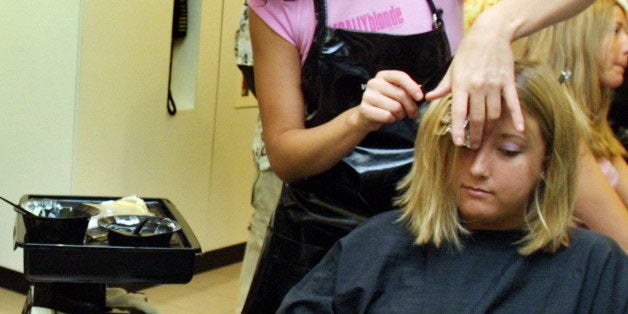
For many ladies, summer means it's time to lighten their hair. Just look at the new blonde(r) hairdos from celebrities like Idina Menzel, Khloé Kardashian and Beyoncé.
While bleached-blonde hair may accentuate sun-kissed complexions and pair nicely with all-white outfits, hair specialist Robert Dorin of True & Dorin Medical Group says there are drawbacks to going lighter that every woman should know.
In order for bleach to actually lighten hair, the product raises hairs' outer cuticle, making it so strands are not smooth and flat. "Hair becomes frayed making it brittle, dry, and more susceptible to tangling together, causing a bird's nest type of effect," Dorin said.
If you're thinking of going blonde this summer, read on for Dorin's words of caution about bleaching hair.
"It is impossible to make your hair lighter without the use of a bleaching/oxidizing agent so no matter what, your hair will reap some type of damaging effects," said Dorin.
The amount of damage bleach causes depends on the change in hair color.
If your hair is brunette or on the darker side, making hair lighter is most damaging because the bleaching agent generally used has to be strong and left on the hair for a longer period of time. Redheads typically fall in the middle on this hair color scale, according to Dorin. Less damage occurs when light hair goes lighter.
When hair is bleached, UV rays and other environmental elements intensify the damage.
"UV rays, humidity, wind, etc. all damage hair in the sense that they suck moisture out of strands, leaving hair frayed, dry and brittle. These elements escalate dryness by continually stripping hair of its natural moisture and nourishment," said Dorin. "Your hair can very much be compared to a sponge -- whatever chemicals you put into it will absorb to only dry out and become ruined."
There are smart ways to go about bleaching hair.
For starters, Dorin recommends always getting hair lightened professionally. "Also, you should gradually lighten hair (making multiple trips to the salon) instead of going from dark to platinum in one step, for example. This will most likely just completely destroy the hair," he said.
Also, use sulfate-free products and deep conditioners a few weeks prior to lightening hair and continue use of these products afterward coloring strands to help add hydration to your locks. Glazes and hair toners are also safer alternatives to dying if you prefer to do so at home. Just be sure to consult with your colorist.
The best way to fight back against bleach-damaged hair is by restoring moisture and limiting heat styling.
Dorin believes that the more moisture you pump into your hair, the better. Chemically-lightened hair is more vulnerable to harsh environmental elements and heat styling tools such as flat irons and hair dryers, so you need to be extra cautious. Guard your hair with a heat protectant product and limit heat styling to minimize damage.


